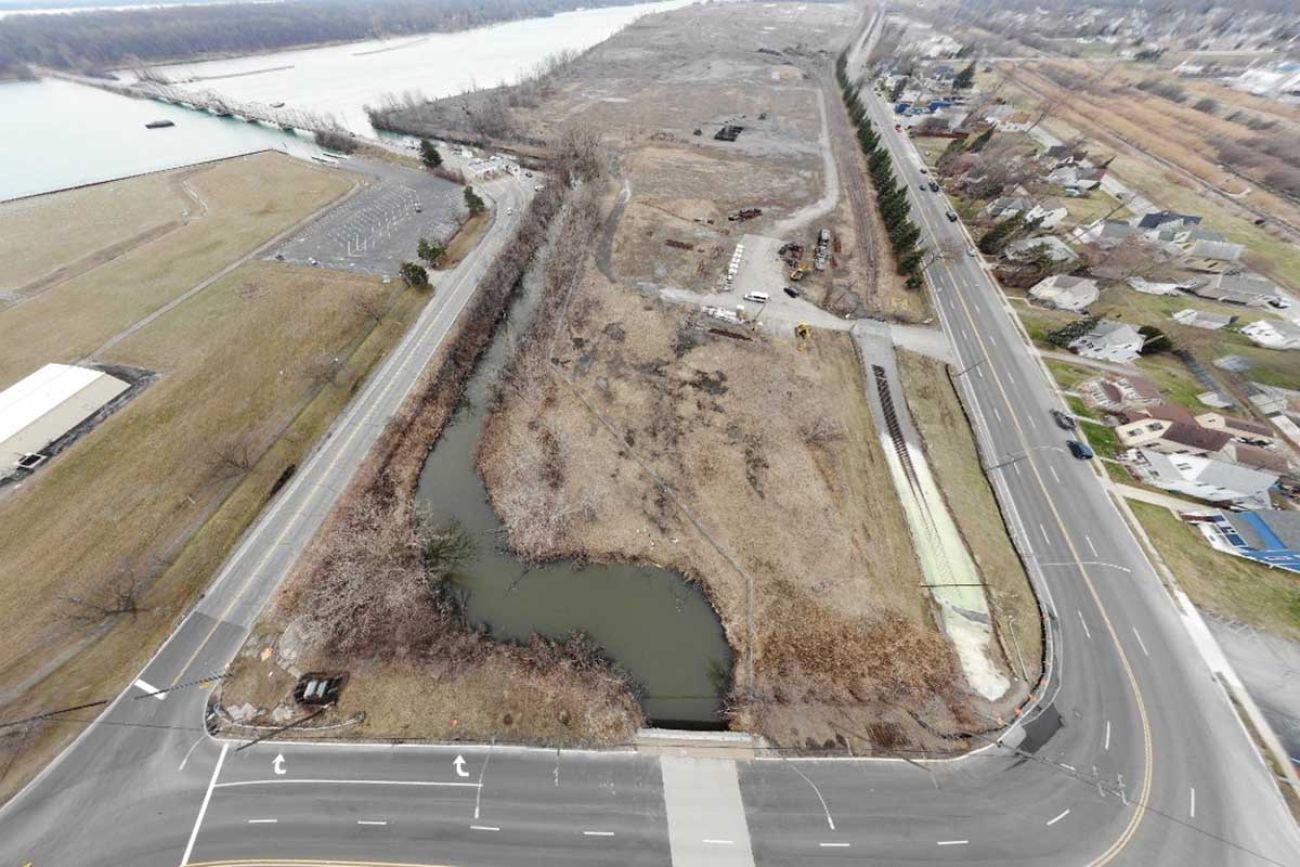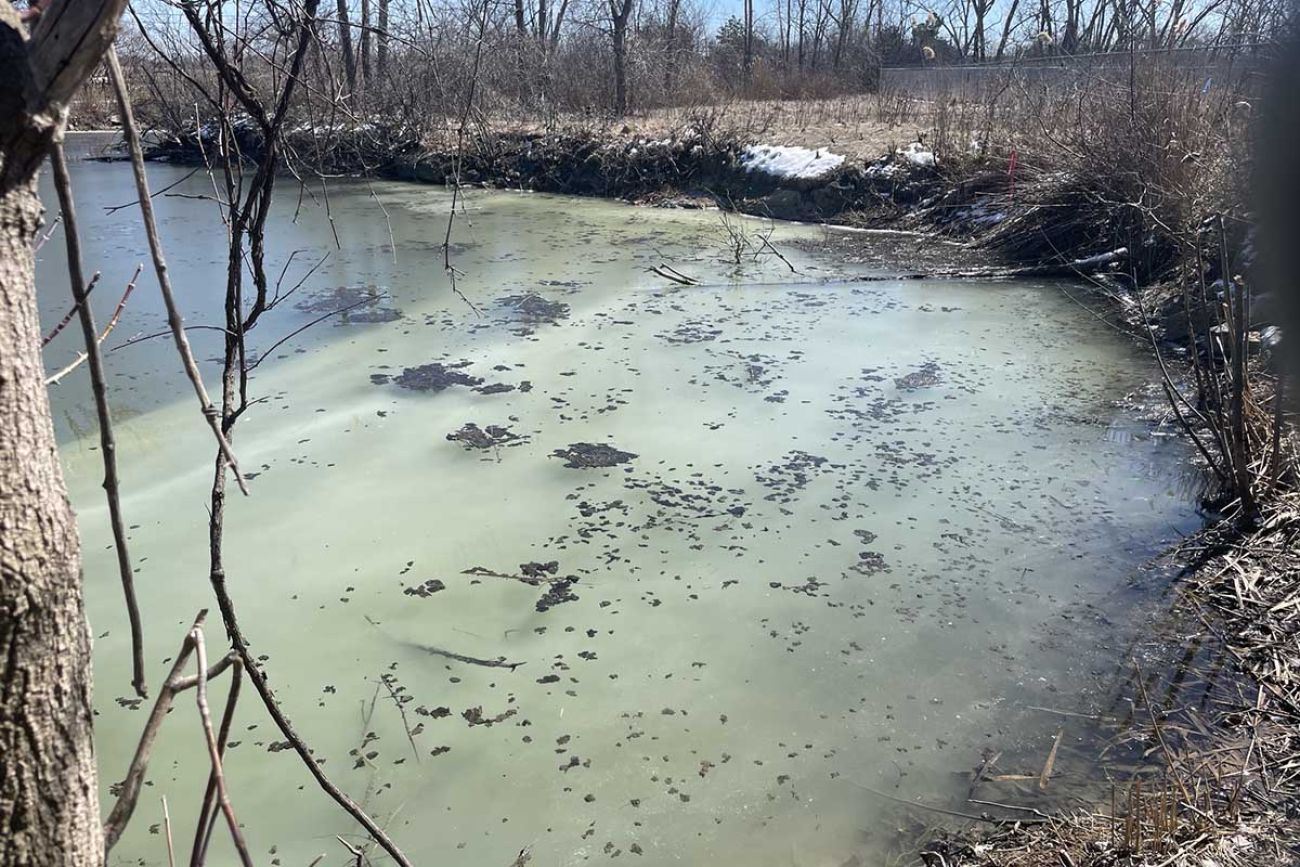Demands for cleanup at contaminated Michigan industrial site. ‘Job is not done’


- State officials are evaluating finding caustic chemicals along a railroad and in a creek near a long-contaminated former steel mill on the Detroit River.
- About $20 million in cleanup already has taken place, but plans are taking shape to address concerns on the northern portion of the site.
- The latest contamination is raising new calls for urgency for the next steps.
Dead fish and milky puddles of water found this spring on the northern edge of one of Michigan’s most contaminated former industrial sites are prompting calls for renewed cleanup urgency.
Among the contaminants found at the former McLouth Steel site on 273 acres near the Detroit River in Trenton is buried calcium hydroxide, known as slaked or caustic lime, which is similar to undiluted bleach and can cause chemical burns.
Testing in March and April by Michigan Department of Environment, Great Lakes and Energy (EGLE) shows that high levels of the chemical were present in both groundwater and in puddles along the railroad tracks where construction crews are working on the Downriver Detroit property close to the toll bridge to Grosse Ile.
Since those tests — prompted by a concerned resident’s alert in late February — the state has warned property owner Crown Enterprises to take control of the property to prevent more chemical migration after officials "observed imminent and substantial threat to human health or the environment."
U.S. Rep. Debbie Dingell, a Democrat from Michigan’s 6th Congressional District, now is calling on state and federal regulators to speed up their work on reducing the environmental risks at the former steel mill.
“It is unacceptable for this level of pollution to continue,” Dingell wrote in a letter to EGLE and the U.S. Environmental Protection Agency (EGLE) that she sent on Wednesday.
While some pollutants have been removed from the southern portion of the site during a $20 million cleanup completed in 2021, a second phase on the northern segment has been set to start this year, but details remain undetermined, Dingell noted in her letter.

The notification from EGLE to Crown follows notification last fall from EGLE that more corrective action is needed at the site to determine if contaminated groundwater may be venting to the Trenton Channel of the Detroit River.
Since the caustic lime discovery, reported to EGLE in February, the creek area is now included among the areas of the northern portion of the property that needs to be further assessed, EGLE told Crown.
The situation is the latest contamination alarm among many since McLouth Steel filed for bankruptcy in 1995 and left the residue of four decades of turning hot iron into steel. Among the chemicals left in the soils are excessive amounts of arsenic, semi-volatile organic compounds, benzene and vinyl chloride, according to a groundwater investigation in 2021.
Undetermined is the site’s impact on people’s health, since contact with calcium hydroxide can cause skin irritation or chemical burns. EGLE officials said no nearby drinking water wells are near the property.
The Michigan Department of Health and Human Services is leading a health assessment study on the chemical releases at the former steel mill. Bridge Michigan asked state officials for information on the study, which is funded by the federal Agency for Toxic Substances and Disease Registry (ATSDR). The state did not reply in time for this story.
The steel mill’s history got complicated after McLouth’s bankruptcy filing, leaving both EGLE and the EPA responsible for separate portions of the site. The EPA oversaw the $20 million cleanup on the southern portion of the property, while EGLE was set to start its similar work on the northern portion this year.
According to EPA records, a new entity attempted to re-open a mill on the site’s 273 acres shortly after McLouth’s bankruptcy, but then in 2000 sold 79 acres at the north to a company owned by the late Manuel "Matty" Moroun, who also owned the Ambassador Bridge among other commercial properties across the U.S.
Moroun’s Crown Enterprises, based in Warren, in 2019 acquired most of the remaining property, which in 2017 had reverted to Wayne County due to tax foreclosure.
In 2019, the former McLouth Steel site was added to the EPA’s National Priorities List, becoming a so-called Superfund cleanup site. Crown reached a settlement agreement with the U.S. Department of Justice, the EPA and EGLE that limited its spending for environmental cleanup, since it is not the company responsible for it, and set the oversight boundaries for EGLE and the EPA.
The visible signs of contamination on the northern portion of the property this spring came after significant rain storms, said Jeff Johnston, EGLE spokesperson.
EGLE now is investigating the puddling contamination separately from the creek, Johnston said, since they appear to be two different sources though both are likely the result of long-buried waste.
“EGLE has confirmed that the current work is not causing or exacerbating the issue,” Crown spokesperson Esther Jentzen said about the railroad-area work on West Jefferson.
The company, which has said it plans to sell the property for redevelopment, “is completing a rail crossing over Jefferson to reconnect the site to the existing railroad track in the area,” Jentzen added.
Fencing around the railroad construction site has been expanded, Johnston said, to keep people from the caustic chemical, and Jentzen said the company is shipping the water off-site for disposal.
“That material was not running off into a waterway… We didn't observe anything escaping, like into the environment,” Johnston said.
EGLE will continue to monitor the property, he said.
The killed fish, Johnston said, appear to be from “intermittent releases through the groundwater … at a high enough concentration.”
Unclear is how long releases may have been taking place, Johnston said. Aerial photos show that the creek’s intermittent cloudiness dates back to 2015.
Crown, meanwhile, will be responsible for investigating groundwater contamination, controlling duet and evaluating how to keep stormwater from moving into the Detroit River, the state says, along with the waste disposal sites on the northern section of the property.
While she called the plant’s cleanup to date as a “historic win” for Detroit’s Downriver communities in the letter, Dingell also said nearby communities need more information on what chemicals are present and which remedies are under consideration.
“The job is not done,” Dingell said.
Business Watch
Covering the intersection of business and policy, and informing Michigan employers and workers on the long road back from coronavirus.
- About Business Watch
- Subscribe
- Share tips and questions with Bridge Business Editor Paula Gardner
Thanks to our Business Watch sponsors.
Support Bridge's nonprofit civic journalism. Donate today.
See what new members are saying about why they donated to Bridge Michigan:
- “In order for this information to be accurate and unbiased it must be underwritten by its readers, not by special interests.” - Larry S.
- “Not many other media sources report on the topics Bridge does.” - Susan B.
- “Your journalism is outstanding and rare these days.” - Mark S.
If you want to ensure the future of nonpartisan, nonprofit Michigan journalism, please become a member today. You, too, will be asked why you donated and maybe we'll feature your quote next time!


